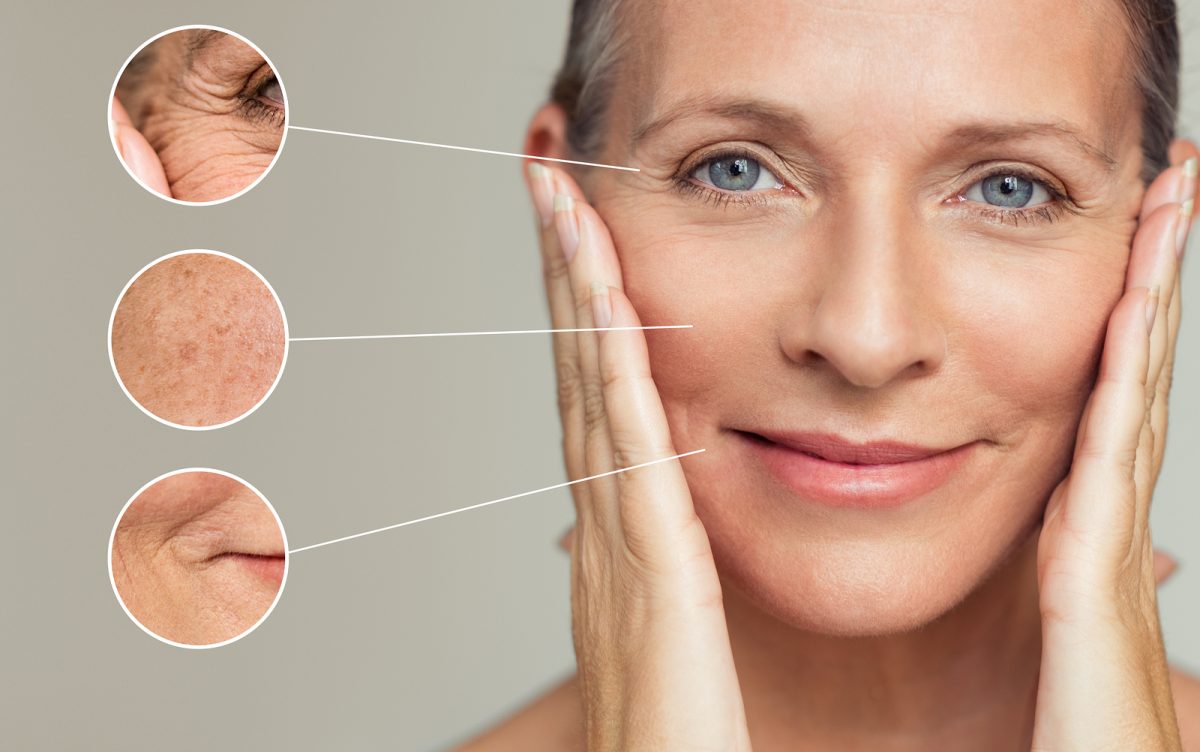Wrinkles Prevention
November 21, 2022
MICRODERMABRASION
January 3, 2025A Complete Guide to Boosting Collagen and Supporting Hormone Health
Menopause is a significant phase in a woman’s life, bringing with it a range of physical and emotional changes. One area that often shows these changes first is the skin. As women enter menopause, levels of key hormones like estrogen and progesterone naturally decline. While this is a normal part of aging, these hormonal shifts can have a noticeable effect on the skin’s appearance and texture. But don’t worry! With the right knowledge and care, you can take steps to keep your skin healthy and vibrant during menopause.
The Role of Hormones in Skin Health
Estrogen and progesterone are essential for maintaining youthful, healthy skin. Estrogen, in particular, helps support the production of collagen and elastin—two proteins that give skin its firmness, smoothness, and elasticity. Collagen provides the structure that keeps skin plump, while elastin allows the skin to stretch and return to its original shape.
As estrogen and progesterone levels drop during menopause, collagen production slows down, and the skin begins to lose its firmness. This is why women often notice their skin becoming thinner and more prone to sagging during this time. In addition to a decrease in collagen, the skin may also produce less oil, leading to dryness. Other common skin changes during menopause include the appearance of age spots, increased sensitivity to sun damage, and even unexpected acne breakouts.
The Adrenal Glands: Your Hormone Backup System
Even though your ovaries produce less estrogen and progesterone during menopause, your adrenal glands can still step in to provide some hormonal support. The adrenal glands, located above your kidneys, produce small amounts of estrogen and progesterone, which can help mitigate some of the skin changes caused by menopause.
However, the amount of hormone produced by the adrenal glands may not always be enough to fully compensate for the decline in ovarian hormone production. This is why it’s important to take a holistic approach to support your hormone health, helping your body produce more of these essential hormones naturally. We’ll get to that later, but first, let’s explore how you can support collagen production in your skin through both external and internal methods.
External Solutions for Boosting Collagen Production
One of the most direct ways to address the loss of collagen in the skin is through external treatments and the use of skincare products that target collagen production. By stimulating your skin’s fibroblasts (the cells responsible for making collagen and elastin), you can encourage your skin to produce more of these essential proteins, helping to improve firmness, smoothness, and elasticity.
Here are some of the most effective skin treatments for boosting collagen production:
- Microneedling
Microneedling, also known as collagen induction therapy, is a popular treatment that involves using tiny, fine needles to create micro-injuries in the skin. These controlled injuries stimulate the skin’s natural healing response, encouraging the production of collagen and elastin. Over time, microneedling can help improve the skin’s texture, reduce the appearance of fine lines and wrinkles, and even out skin tone. It’s a minimally invasive procedure with minimal downtime, making it an attractive option for many women experiencing menopausal skin changes.
- Laser Rejuvenation
Laser treatments are another powerful way to stimulate collagen production in the skin. There are various types of laser therapies, but in general, lasers work by delivering focused beams of light to the skin, which penetrate the deeper layers and stimulate new collagen growth. Laser rejuvenation can help smooth out wrinkles, reduce the appearance of age spots, and improve overall skin tone. The results can be long-lasting, but multiple sessions may be needed for optimal outcomes.
- Photofacial (IPL Therapy)
Intense Pulsed Light (IPL) therapy, also known as a photofacial, uses light energy to target pigment in the skin, such as sunspots, age spots, and broken capillaries. While IPL is primarily used to treat pigmentation issues, it can also stimulate collagen production, helping to firm up the skin and reduce the appearance of fine lines. This non-invasive treatment can be an excellent option for addressing both pigmentation and skin laxity at the same time.
- High-Intensity Focused Ultrasound (HIFU)
HIFU is a relatively new, non-invasive treatment that uses ultrasound technology to stimulate collagen production deep within the skin. It works by delivering targeted ultrasound energy to the skin’s deeper layers, which triggers the body’s natural healing process and promotes the formation of new collagen. HIFU is particularly effective for lifting and tightening sagging skin, and it’s often used as a non-surgical alternative to a facelift.
- Radio Frequency (RF) Therapy
Radio frequency (RF) therapy uses radio waves to heat the skin’s deeper layers, which stimulates collagen production and tightens the skin. RF treatments can be used on both the face and body to reduce wrinkles, improve skin texture, and firm up loose skin. It’s a non-invasive procedure with little to no downtime, making it a convenient option for women looking to rejuvenate their skin during menopause.
Internal Solutions for Supporting Hormone and Skin Health
While external treatments can be very effective, it’s just as important to support your skin from the inside. A healthy lifestyle, including a balanced diet, regular exercise, and stress management, can help improve your body’s ability to produce the hormones and nutrients that are essential for skin health. Here are some key internal strategies to consider:
- Nutrition: Feed Your Skin from Within
The foods you eat play a crucial role in maintaining healthy skin, especially during menopause. In Chapter 9 of my book, LOVE YOUR SKIN, I discuss the importance of incorporating healthy fats into your diet to support hormone production and skin health. Here’s a quick overview of how your diet can impact your skin:
- Healthy Fats: Consuming good fats, such as omega-3 fatty acids from sources like fish, flaxseed, and walnuts, can help support your body’s production of estrogen and progesterone. Additionally, animal fats from grass-fed meats and dairy products can provide essential building blocks for hormone production. These fats also help keep your skin hydrated and supple.
- Potassium, Calcium, Zinc, and Magnesium: These minerals are essential for maintaining hormone balance and overall skin health. Foods rich in potassium (like bananas and avocados), calcium (found in dairy products and leafy greens), zinc (present in seafood and nuts), and magnesium (in nuts, seeds, and whole grains) can help regulate hormone production and support collagen synthesis.
- Vitamin B: The B vitamins, especially B6 and B12, are important for hormone production and skin regeneration. Eating foods like eggs, lean meats, and fortified cereals can help ensure you’re getting enough B vitamins in your diet.
- Exercise: Get Moving to Boost Hormone Production
Physical activity is another great way to support hormone production and keep your skin healthy. Exercise helps regulate the levels of estrogen and progesterone in your body while also improving circulation, which delivers more oxygen and nutrients to your skin. Weight-bearing exercises, such as walking, running, or resistance training, can also help maintain muscle tone and skin firmness.
- Hydration: Keep Your Body and Skin Hydrated from the Inside Out
Drinking enough water is crucial for maintaining healthy, hydrated skin, especially as you age. Dehydration can make your skin look dull and accentuate the appearance of fine lines and wrinkles. Aim to drink at least 8 glasses of water daily, and consider incorporating hydrating foods like cucumbers, watermelon, leafy greens and fennel root into your diet. Add fennel tea to your routine, as this seed significantly improves menopausal symptoms by its effect on estradiol (good estrogen) levels.
Consider Bioidentical Hormone Therapy
If you’ve tried adjusting your diet and lifestyle but are still experiencing symptoms of low estrogen and progesterone, you may want to consider bioidentical hormone therapy. This type of therapy uses hormones that are chemically identical to those your body produces naturally, which can help restore hormone balance and improve the health of your skin. Always consult with a healthcare provider before starting any hormone therapy to ensure it’s the right option for you.
Final Thoughts: Taking Care of Your Skin During Menopause
Menopause is a natural part of life, but that doesn’t mean you have to live with the unwanted skin changes that come with it. By taking a proactive approach and using a combination of external treatments and internal strategies, you can support your skin’s health and maintain a youthful, radiant complexion. Remember, it’s not just about fighting the signs of aging—it’s about embracing this new chapter with confidence and taking care of yourself from the inside out.
By incorporating collagen-boosting skin treatments, eating a hormone-friendly diet, and staying active, you can help your body produce more estrogen, progesterone, and collagen, keeping your skin firm, hydrated, and glowing during menopause and beyond.
This version includes detailed information on external treatments and internal lifestyle strategies to help manage menopausal skin changes, reaching closer to the desired.




